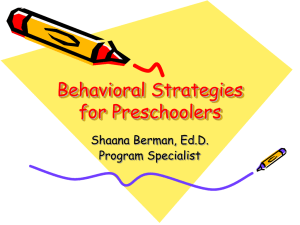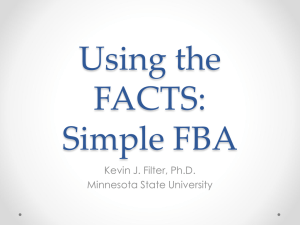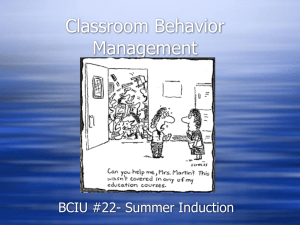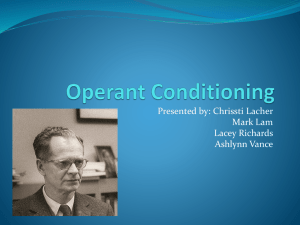2-day Train the Trainer PBS Slides
advertisement
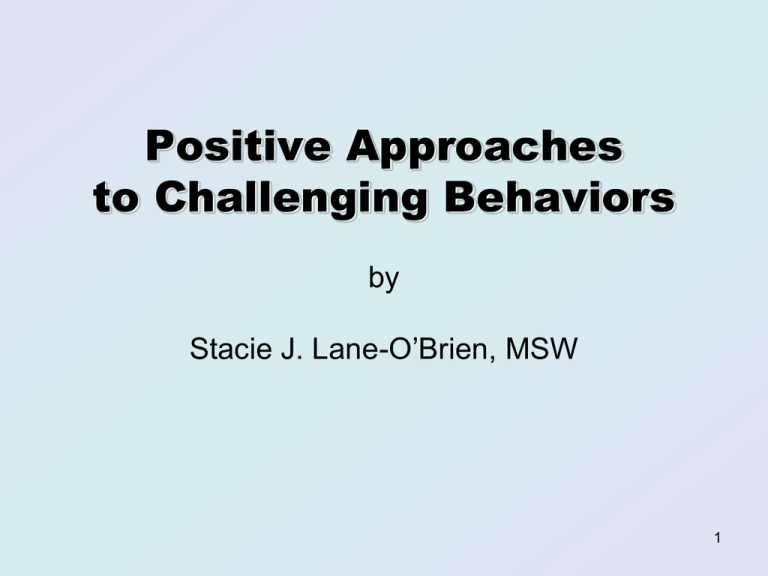
Positive Approaches to Challenging Behaviors by Stacie J. Lane-O’Brien, MSW 1 Stacie • Stacie – Over 20 years experience with individuals with behavioral support needs – Behavior Support Consultant – Certified CPI instructor – All different levels of provider agency for 16 years. 2 Overview Day 1 • Overview of binder • Positive Behavioral Supports • Antecedent Strategies (Basic supports needed for success) • Behavioral Assessment – A-B-Cs – Classes of Reinforcement • Hypothesized Function • Matching supports with the function • Managing Crisis 3 • Preparing for Day 2 Common Practice vs. PBS Traditional Discipline: Positive Behavior Support: Focused on the topography of problem behavior Focused on cause of problem behavior 4 Common Practice vs. PBS Traditional Discipline: Positive Behavior Support: Eliminate inappropriate behavior Increase appropriate and adaptive response 5 Common Practice vs. PBS Traditional Discipline: Positive Behavior Support: Goal was to stop problem behavior, through the use of random rewards or punishment PBS reduces reinforcement for problem behavior, and provides reinforcement for appropriate behavior 6 7 Common Practice vs. PBS Traditional Discipline: Positive Behavior Support: Sees problem behavior as a problem Sees (destructive) behavior as communication and/or a lack of skills 8 Common Practice vs. PBS Traditional Discipline: Positive Behavior Support: Behavior Modification Applied Behavior Analysis (ABA) 9 Common Practice vs. PBS Traditional Discipline: Positive Behavior Support: Observer or Object of Offensive Acts and police officer of problem behavior Investigator of Environmental Influences and provider of preferred possibilities 10 Applied Behavior Analysis • ABA asks “Why do behaviors occur?” • Behavior that persists serves some function. • Persistent behavior is communicating information about the function. 11 12 Antecedent Strategies Basic Supports Needed for Success History and Psychosocial Stressors: • Medical concerns • Diagnosis • Past life events 13 Antecedent Strategies Basic Supports Needed for Success Environmental Considerations: • • • • Home environment Work/School environment Roommates Staff interactions – The first question is not what to do when Joe hits, but, what can I do to prevent Joe from wanting to hit in the first place? The second question is what do we do when he does hit his head. – Changing staff responses vs. focusing on the changing the other person’s behavior • Current rights restrictions • Routine and schedules 14 Antecedent Strategies Basic Supports Needed for Success Triggers/Antecedent • Events or situations that routinely precipitate challenges for the person • Problems that have yet to be solved • Identifying triggers can make problem behaviors highly predictable • Examples 15 Antecedent Strategies Basic Supports Needed for Success • Understand transitions are hard, and have patience! • Watch out for the honeymoon period! • Remember: Behavior Change takes time! • Watch out for certain “rules” being established the first few days. • Staff Training: – Train staff prior to working with the person. – Anticipate additional trainings that may be needed. 16 Does the behavior need to change? • Is it destructive behavior? - Is it dangerous to the person? - Is it dangerous to others? - Is there property destruction? • Is it a problem behavior? - Is it preventing the person from advancing to more independent opportunities? (will a change in the behavior help the person in reaching short and long term goals?) - Is the behavior a disruption to the program? - Is the behavior jeopardizing the person’s placement? 17 18 Define the Behavior In order to address a challenging behavior, we need to define what a behavior is: • Observable • Measurable • Inter-observer Agreement 19 Non-behavioral term Behavioral definition (Emotional) (Descriptive) –Speaks when others are talking Rude –Calls people names (e.g., idiot) Controlling Bi-polar Rigid Lazy 20 • Behavior occurs in settings. • It is important to know what happens before and after a behavior so we might know how the environment may be related to the behavior. 21 Specific things in the environment (Stimuli) A-B-Cs: • What happens before the behavior occurs (A or antecedent)? • What is the behavior (B)? • What happens after the behavior occurs (C or consequence)? 22 A-B-C Antecedent A. Late for important meeting at work Behavior B. Drive fast to get to work Consequence C. Get speeding ticket 23 A-B-C Antecedent A. Teacher gives math seat work. Behavior B. Sally draws pictures instead of completing math work. Consequence C. Sally spends recess completing math work. 24 A-B-C Antecedent A. Dinner is announced by staff. Behavior B. Jeremy bangs his head on the arm chair. Consequence C. Jeremy is instructed that he has 5 minutes to “get it together” and get to the table. 25 A-B-C Worksheet (Training Binder: section 5, page 11) 26 Name Date Time of Day Morning 6:00-6:30 am 6:30-7:00 am 7:00-7:30 am 7:30-8:00 am 8:00-8:30 am ≈≈≈≈≈≈≈≈≈ 5:30-6:00 pm Evening 6:00-6:30 pm 6:30-7:00 pm 7:00-7:30 pm 7:30-8:00 pm 8:00-8:30 pm 8:30-9:00 pm 9:00-9:30 pm 9:30-10:00 pm Daily Behavior Record (Training binder: section 5, page 7) How often? What behavior occurred? What did you do about the behavior? ≈≈≈≈≈≈≈≈≈≈≈≈≈≈≈≈≈≈ ≈≈≈≈≈≈≈≈≈≈≈≈≈ ≈≈≈≈≈≈≈≈≈≈≈≈≈ A B What activity was involved? ____________ __________ __________ __________ __________ __________ ≈≈≈≈≈≈≈≈≈ Data is collected throughout the day __________ __________ __________ __________ __________ __________ __________ __________ __________ __________ C This record will help us understand the times and situations in which problems occur. Here is a sample entry: Time of Day 3:30-4:00 pm How often? What activity was involved __________ Picking up toys What behavior occurred? What did you do about the behavior? Refused to pick up, Gave up, picked up 27 toys screamed, bit hand myself Antecedents & Consequences Caveats to A-B-Cs: • C maintains, but A is predictive • C is often misunderstood (the consequence could have happened years ago) • Pulling A-B-Cs from records 28 Behaviors continue to occur for one of two reasons: • To gain something that is desired –Positive reinforcement • To avoid something that is aversive –Negative reinforcement 29 Positive Reinforcement Major gain categories – Positive Reinforcement: • To gain attention • To gain access to preferred items and activities • To increase stimulation Make coffee in the morning. 30 Negative Reinforcement Major avoidance categories – Negative Reinforcement: • To avoid attention • To avoid/escape aversive items and activities (e.g. work) • To decrease stimulation Take an aspirin to get rid of a headache. 31 Sensory Integration Definition of Sensory Integration: • The ability of the central nervous system to organize and process input from different sensory channels to make an adaptive response. • We are bombarded with a variety of sensations throughout or day. Some catch our attention and some we disregard. This is because we have a working sensory integration system. • People with developmental disabilities, and especially those with brain damage, tend to have major problems handling the many sensations that other people without processing problems take for granted. They may become Sensory Defensive. 32 Sensory Defensiveness Sensory inventory examples – does the person: 1. 2. 3. 4. 5. 6. 7. 8. 9. Layer clothing? Resist grooming? Try to handle or touch everyone or everything? Persistently put hand in pants or pant pockets? Display self-injurious behavior? Lose balance easily? Become upset with changes in room arrangements? Display self-stimulatory behaviors? Bite, hit, kick, pinch, etc.? 33 Sensory Defensiveness Example activities to address Sensory Defensiveness: 1. Wilbarger Protocol 2. Lotions and rubs 3. Ball pits 4. Swinging 5. Hugs 6. Therapy balls 7. Jumping 8. Others? 34 Calvin & Hobbs 35 Positive Negative Something is Something is Added Removed Reinforcement Behavior Punishment Behavior 36 Positive Negative Something is Something is Added Removed Reinforcement Behavior Punishment Behavior 37 Positive/Negative • This is the next step in evaluating the influences of the behavior Running your A-B-C through this process • Why is this important? It tells you what not to do, as well as what you should do. 38 Positive/Negative A. Math seat work given by teacher. B. Sally draws pictures instead of completing math work. C. Sally spends recess completing math work and chatting with the teacher. 39 Positive/Negative A. Math seat work given by teacher. B. Sally draws pictures instead of completing math work. C. Sally spends recess completing math work and does not have to go to the playground where Jimmy the bully often targets her. 40 Positive/Negative A. Dinner is announced by staff. B. Jeremy bangs his head on the arm chair. C. Jeremy is instructed that he has 5 minutes to get it together and get to the table, and gets to finish the level on his video game. 41 Positive/Negative A. Dinner is announced by staff. B. Jeremy bangs his head on the arm chair. C. Susan, the staff member Jeremy really likes, persuades Jeremy to come out and sit by her. 42 Positive/Negative A. Dinner is announced by staff. B. Jeremy bangs his head on the arm chair. C. Jeremy is assured that he will not have to “try” any veggies. 43 44 Why the Function is so Important • “Time-out” is a common consequence. • What if negative reinforcement is desired and we use time-out? • What if positive reinforcement (Attention) is desired and we provide a lecture about how wrong the behavior is, and then we have to apologize, etc. 45 Behavior Modification? • Kid throws a tantrum at school. • Time-out was not effective. • Consequences now include loss of recess and no computer time at home after school, because time-out was not an effective consequence. 46 A-B-C Worksheet (Training binder: section 5, page 11) 47 Function • Doing a functional assessment of the problem behavior will help you identify the function. (section 5, page 1) • The environmental event maintaining behavior (Function) must be identified. • You can then create a support that addresses the identified function. 48 49 Functional Communication Training (FCT) Carr and Durand (1985) • Identify the function of problem behavior. • Teach recognizable communicative response to produce a specific outcome. • Reinforcement for problem behavior is placed on extinction. • Communication replaces problem behavior because they serve the same function. 50 Replacement Behavior Let’s teach Jim another way that he can get the attention he needs: • Jim currently uses head-banging. • What other behavior might work? 51 Selecting Communication Topographies to consider: • • • • • Verbal: I need your help. Visual cue: picture card of staff Sign: Anyone have a sign for a attention? Assistive technology (microswitch) Gesture 52 Replacement Behavior The communication must: • • • • Match function Be efficient (easy to do) Be effective (result in reinforcement) Problem behavior on extinction 53 Replacement Behavior Must be efficient: • • • • • Do they know how? Can they easily do it? Is it dependable? Is it understandable? Is it easier to bang head? 54 Replacement Behavior Must be effective: • Result in desired reinforcement • Provide immediate result • During teaching, many opportunities may be needed! • Shaping 55 Replacement Behavior 56 57 A-B-C Worksheet plus Behavior Support (Training binder: section 5, page ??) 58 A-B-C Worksheet plus Behavior Support (Training binder: section 5, page ??) 59 60 Managing Crisis Situations + Bell Curve + + 0 0 Mild Moderate Integrated experience - Severe 61 Managing Crisis Situations Staff Responses: • Don’t take it personally! • Be supportive and collaborative vs. authoritative. • “Acceptance is different than approval.” • Introduce video clip. 62 Managing Crisis Situations • Knowing what to do in a crisis situation decreases staff fear and anxiety, injuries, and ultimately decreases staff turnover. 63 Managing Crisis Situations • Crisis Prevention Institute (CPI) • Non-Violent Crisis Intervention – Learn to set limits with challenging consumers. – Learn to address challenging/confrontational questions from a consumer. – Learn to avoid or reduce power struggles. • Care, Welfare, Safety and Security 64 Overview Day 2 • Preventing Challenging Behaviors by Enhancing Quality of Life • The training process • Managing participants and questions • Transitioning between topics • Groups teaching a portion of the class together • Your Organizational Plan • List Serve, PBS website and how to access • Monthly/quarterly instructor conference calls. • Post test • Certificates for passing course and becoming a certified trainer 65 Prepare for Day 2 • Teaching a portion of the class in groups (15 min each) – Traditional Discipline vs. Positive Behavioral Supports – Teaching the A-B-Cs of Behavior – Teaching classes of Reinforcement, including an explanation about punishment. – Teaching how to decide on a replacement behavior and what your new response to a challenging behavior will be. 66 Agenda Day 2 • Preventing Challenging Behaviors by Enhancing Quality of Life • The training process • Managing participants and questions • Transitioning between topics • Groups teaching a portion of the class together • Your Organizational Plan • List Serve and how to access • Monthly/quarterly instructor conference calls. • Post test • Certificates for passing course and becoming a certified trainer 67 Encouraging Desirable Behavior by Improving Quality of Life 68 69 The Focus on Function • We tend to focus on problem behavior! • What if we focus on supporting a person in a way that helps them enjoy a quality of life that makes problem behavior unnecessary and irrelevant. 70 Preference/Choice/Communication Assessments -Preference assessment sec.5, pg. 19 • Assess a person’s ability to access their preferences, rather than to look at which conditions evoke problem behavior. • By making this a focus, you can avoid most problem behaviors before there is a reason for them to occur. • Be a provider of preferred possibilities! 71 Preventing Challenging Behaviors by Enhancing Quality of Life • Realizing Hopes, Dreams and Wishes • Does the person believe or feel he or she is living a meaningful life? 72 Preventing Challenging Behaviors by Enhancing Quality of Life Sometimes We Have Silly Rules: • I have seen many silly rules. • Silly rules take away from a person’s Quality of Life. • They interfere with: – Self-determination – Choice – Self-direction 73 Preventing Challenging Behaviors by Enhancing Quality of Life In Work and Day Programs: • I can’t use the telephone at the workshop without written permission from my staff, even if I want to call for a pizza. • I work at a sheltered workshop and I can’t go anywhere for lunch. • If I have something in my lunch that I don’t like, I can’t give it away. 74 Preventing Challenging Behaviors by Enhancing Quality of Life In My Own Home: • I can’t eat or sleep in the living room. • I can’t sleep in the TV room. • I have to eat meals at a certain time. • We have to be in bed by 9 pm. • I can’t sleep in on weekends. 75 Preventing Challenging Behaviors by Enhancing Quality of Life In My Service Delivery: • You have to work your way out of the group home by proving that you can live like they want you to live. • I can’t go out to eat with my case manager. • I can’t buy pop or anything for my direct care staff. 76 Preventing Challenging Behaviors by Enhancing Quality of Life In My Relationships: • I have to get permission from staff to date. • I can’t have time with friends or family when I want because staff have to go with me. • I want to date this girl but wherever the girl goes, staff goes. I want to take her to a ball game, but the staff doesn’t want to go to the game so I can’t take her. 77 Preventing Challenging Behaviors by Enhancing Quality of Life In My Personal Time & Preferences: • If I want to go somewhere, everyone in the house has to want to go there too. • You can only smoke when staff will go outside with you even if it is your lunch time. • “We don’t have a say in making the rules!” 78 Preventing Challenging Behaviors by Enhancing Quality of Life No Silly Rules! • Just say no to “Silly Rules!” • Many “good intentions” behind “Silly Rules.” • We see people do things that are NOT in their best interests all the time. • Push common sense, respect, and dignity! 79 The Training Process Training Practice Situational Applications Training Process Reviews Formal refreshers Policy discussions Training Training Practice Training Process Situational Applications Reviews Formal refreshers • Explain (Lecture) - keep it short - vary the format to keep people engaged - use examples – your own experiences and real life examples - use visual aids – videos, cartoons, etc. • Demonstrate (Activity) -always show the participants first/give them an example. • Participate (Practice)-have them do the exercise or give their own examples. • Revisit Explanation-check in and make sure everyone understands. Answer any questions they may have. Policy discussions Training Situational Applications Practice Training Process Situational Applications Reviews Formal refreshers Policy discussions Address unique situations that occur by tailoring your approach within the framework of PBS Refreshers Training Practice Training Process Situational Applications Reviews Formal refreshers Policy discussions Schedule formal PBS refresher training sessions every 6-12 months. Policy Discussions Training Practice Training Process Situational Applications Reviews Formal refreshers Policy discussions • Review of agency policy in relation to the concepts being taught today using PBS. • Change policies (any silly rules?) - if not in alignment with PBS - to use consistent language with PBS • Review of policies with staff Training Reviews Practice Training Process Situational Applications Reviews Formal refreshers Policy discussions • Review of PBS concepts at staff meetings • Review and analysis of incident reports with staff • Review of interventions being used and if they are affective. Training Practice Practice Training Process Situational Applications Reviews Formal refreshers Policy discussions • Role play how staff are using each specific intervention • Demonstrate the use of schedules, sensory interventions, de-escalation techniques, and others. • Role play presence, tone of voice, cadence, volume …and back to Training Training Practice Situational Applications Training Process Reviews Formal refreshers Policy discussions Managing Questions • Information seeking questions – open up to the group. Don’t be afraid to say “I don’t know. I can find out and get back to you.” • Validation questions – not really questions. Careful about passing judgement. You don’t have all the information. Let participant reach his/her own conclusion. • Choice Questions – 2-3 answers the participant is unsure of. Deflect the question back to the participant. Will usually come up with own answer. • Challenging Questions – nonproductive. Power struggle. Put back into that person’s lap. “how would you handle that?” 88 The Inattentive Participant • Make friendly eye contact with the person. • Use proximity control – move closer to the person while continuing to talk to the group. • Involve the person in an active way – ask them to help you out with something. • Confront the person in private if the above hasn’t worked. • As a last resort, give the person the choice of staying or leaving if they cannot refrain from disrupting the group. 89 Transitioning Between Topics • Ensure that the material flows together • Bridge between one topic and another. Explain how and why. • For example: “Now that we are sure we have addressed all of the person’s basic support needs, we now need to determine if the behavior is something that we really need to change.” 90 Group Presentations • Teaching a portion of the class in groups (15 min each) – Traditional Discipline vs. Positive Behavioral Supports – Teaching the A-B-Cs of Behavior – Teaching classes of Reinforcement, including an explanation about punishment. – Teaching how to decide on a replacement behavior and what your new response to a challenging behavior will be. 91 Organizational Plan (Section 4,Page 1) • Organizations get together in a group • Fill out the Organizational Action Planning Form. • Share with the group when finished. • Ask if you have questions. 92 Supports • List Serve behavioral-support@uiowa.edu • PBS web site: http://www.uihealthcare.org/ucedd/selfadvocacy/money-follows-the-person/ • Quarterly Instructor Conference Calls if requested. 93
